The municipal bond market is currently witnessing notable developments characterized by fluctuating yields, significant inflows into mutual funds, and strategic issuer activity. Given its cyclical nature intertwined with political and economic changes, this analysis aims to provide a critical examination of recent trends, particularly how the municipal sector navigates an evolving financial climate.
Market Performance amid Economic Signals
The recent firmness in the municipal bond market can be attributed to the rallying yields of U.S. Treasuries and positive movements in equity markets. As previewed by market data, the ratios of two-year municipal to U.S. Treasury securities (UST) displayed a range of 61% to 86%, a sign of relative value that is compelling investors to shift their focus to municipal bonds. Portfolio managers, such as James Welch from Principal Asset Management, highlight that the trajectory for munis hinges heavily on federal policies and economic adjustments prompted by the current administration. The interplay of these factors can lead to both challenges and opportunities for municipal issuers and investors alike.
Despite a backdrop marked by trade tariffs and budgetary concerns, the municipal market has demonstrated a robust ability to absorb shocks and adapt to the macroeconomic landscape. While performance metrics indicate that munis have lagged behind other significant asset classes, the consistent inflow into municipal mutual funds—evident with $238.5 million added in just one week—reinforces investor confidence. High-yield funds, in particular, have experienced noteworthy demand, showcasing a trend where cautious optimism prevails among municipal investors.
One of the more profound developments influencing the municipal landscape is the increase in issuance to $50.74 billion year-to-date, reflecting a 12.5% rise from the previous year. This upsurge is coinciding with an evident “deferred maintenance” crisis, wherein many issuers can no longer depend on supplemental pandemic-era funding, compelling them to actively seek capital markets for necessary project funding. Welch notes the continued activity in the municipal market, positioning it as a resilient avenue for raising funds amid tightening financial conditions.
In conjunction, the demand from retail investors—spanning traditional mutual funds, exchange-traded funds (ETFs), and separately managed accounts—remains vibrant. As federal money diminishes, this growing retail participation underscores the shifting dynamics within the market and illustrates the importance of local and individual investors in stabilizing municipal funding.
Impact of Yield Curve Dynamics
The current municipal yield curve presents a complex landscape, particularly concerning the shorter-end yields and their relation to cash management strategies. Portfolio manager Kim Olsan emphasizes that a recent sharp rise in the 7-day SIMFA rate, alongside fluctuations in municipal market spaces, suggests cash products are increasingly attractive to investors. However, the gradual decline in tax-exempt money market balances highlights waning demand in this sector as tax-exempt opportunities become pricier.
As the yield curve exhibits steepness beyond the 10-year mark, this has incited strategic moves from investors seeking higher yields. Olsan observes a marked trend where funds are reallocating towards longer-dated bonds, potentially curbing defensive holdings to chase returns in a more favorable environment.
The primary municipal market is also active, with notable transactions such as the Kentucky Public Energy Authority’s significant issuance of gas supply revenue bonds. Financial institutions like Morgan Stanley and Barclays are pivotal in pricing these bonds, often reflecting credit quality risks and expected cash flows. During this recent surge, bond credit ratings also come into sharp focus, with institutions keenly analyzing factors contributing to the creditworthiness of issuers.
Regional distribution of bond issuance, like the $854 million in airports system revenue bonds in Hawaii, illustrates diverse municipal financing needs. Moreover, the stratification of maturities and callable options within these transactions represents nuanced strategies employed by borrowers to optimize financing costs.
The ongoing evolution of trading practices, particularly the integration of electronic trading (e-trading), has fundamentally transformed engagement in the municipal market. As trading volumes approach record levels, the rise of separately managed accounts (SMAs) underscores an increasing demand for efficient management. E-trading facilitated a 14% growth year-over-year in SMA volumes, as market participants leverage technology to streamline operations.
Furthermore, the accessibility of e-trading platforms is pivotal in driving retail investor participation, making municipal bonds more attractive to a broader demographic. This democratization ties back to the growing trend of fully automated account management, where technology minimizes the need for human intervention in trading decisions.
The municipal bond market is characterized by its resilience and adaptability amidst fluctuating yields and economic uncertainties. The intersection of political decisions, technological advancements, and the pressing capital needs of municipal issuers will undeniably shape its trajectory. As investor confidence remains steadfast, understanding the nuances of demand patterns, yield dynamics, and technological integration will be crucial for stakeholders navigating this complex landscape. The current climate presents both challenges and promising avenues for innovation in municipal finance, making it an intriguing sector for continued observation and analysis.

